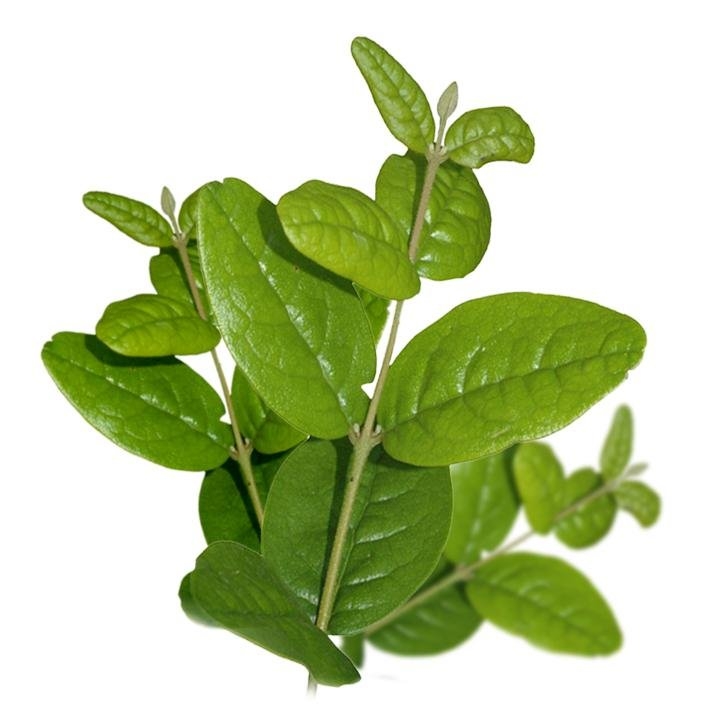Description
Small tree or shrub (5-6 m), dioecious and evergreen, native from Chile. Short and thick trunk; slightly cracked, brownish-grey colored bark; plenty of branches and twigs. Its leaves are aromatic, perennial, opposite, whole, coriaceous, asperous, oval or elliptic, greyish-green colored, generally about 3-8 cm long and 2-4 cm wide, with a short petiole, an obtuse or slightly emarginated or mucronate apex, and a symmetric and rounded base slightly curved towards the back. The upper side is dark green and rugous and it shows numerous marked, small protuberances from glands that contain the aromatic oils, and a depressed vein. The underside is pubescent, and it shows a paler green color and less marked protuberances and a pinnate and prominent vein. Aromatic smell and taste. Unisexual flowers, grouped in terminal cymes of 3-15 flared, axillary, and pale-yellow flowers. Masculine flowers show numerous stamens in different verticils whereas feminine ones have a pistil with numerous uni-ovulate carpels. The fruit is a small, oval-shaped, flesy, juicy and edible black drupe 5-7 mm long. It has an aromatic and bitter scent that resembles that of the lemmon or camphor. It belongs to the Monimiaceae family.
Indigenous of dried mountains in Chile. Occasionally it is also cultivated in Italy and Northern Africa. Boldo mainly develops in dry and sunny land, in little humid areas with stony soils, up to 1,500 meters high, where it can adapt to adverse conditions of drought. It blooms at 4 or 5 years of age, from July to November (winter in Chile). Leaves are harvested during December and January (summer in Chile) although in most cases this process is carried out in autumn. Its seed has abundant endosperm although its propagation is difficult due to the slowness of the germination of the seeds.
Part used
Leaves and sometimes the bark, too.
Indications
Internal use
- Hepatobiliary disorders: hepatitis, hepatobiliary dyskinesia, liver deficiency, liver congestion, bile lithiasis, cholelithiasis, cholecystitis, cirrhosis.
- Digestive disorders: distention feeling upon eating, slow or uneasy digestion, lack of appetite, hyposecreting dyspepsia, meteorism and flatulence, bloated stomach and bitter taste in mouth, gastrointestinal spasms.
- Dryness in mouth.
- Constipation of hepatic origin.
- Migraines produced by bile disorders, headaches and cephaleas.
- Genitourinary infections, cystitis, etc.
- Hepatic origin insomnia, irritability and vertigos.
- Rheumatism, arthritis, hyperuricemy.
- Ascaridiasis: Should not be used as an antihelmintic in children unless supervised by a professional health provider.
External use
- Neuralgias, headaches (compresses).
- Rheumatic pain (poultice, bathes).
- Toothaches.
Bibliography
Plantas Medicinales. Margarita Fernandez y Ana Nieto. Ed Universidad de Navarra. EUNSA 1982.
Matière Médicale. RR Paris- H. Moyse. Masson 1981.
Guía de Campo de las Flores de Europa. Oleg Polunin. Ediciones Omega S.A. Barcelona, 1977.
Guía de las Plantas Medicinales. Paul Schauenberg y Ferdinand Paris. Ediciones Omega S.A.
El gran libro de las Plantas Medicinales. Editorial Everest. S.A.
Plantes Médicinales des Régions Tempérées. L. Bézanger-Beauquene, Pinkas, Torck, Trotin.
Plantas Medicinales. Thérapeutique-Toxicité. Christiane Vigneau. Masson, Paris 1985.
Fitoterapia: Vademecum de Prescripción. Plantas Medicinales. Colaboran: Asociación española de médicos naturistas. Colegio Oficial de Farmacéuticos de Vizcaya.
Pharmacognosy, Phytochemistry, Medicinal Plants. Jean Bruneton. Lavoisier Publishing.
Plantas Medicinales. El Dioscórides Renovado. Pio Font Quer.
Pharmacopée Française IX Édition.
Farmacognosia 2ª Edición. Jean Bruneton. Ediciones Acribia S.A. 2001.
Bulletin officiel Nº 90/22 bis. Ministère des Affaires Sociales et de la Solidarité.
French Public Health Code.
Bross B. Plantas y sus aceites esenciales. Ed. Omega, 1994.
Martindale. The extra Pharmacopoeia 29th Edition. The Pharmaceutical Press 1989.
